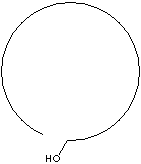PRODUCT IDENTIFICATION
593-50-0: 1-Triacontanol
506-52-5: 1-Hexacosanol

H.S. CODE
TOXICITY
CLASSIFICATION
PHYSICAL AND CHEMICAL PROPERTIES
AUTOIGNITION
NFPA RATINGS
REFRACTIVE INDEX
Stable under ordinary conditions.
GENERAL DESCRIPTION & APPLICATIONS
APPEARANCE
99.0% min (C28:0 60% min)
HEAVY METALS
10ppm max
LEAD
3ppm max
ARSENIC
2ppm max
MICROBILOGICALS
moulds: 50 cfu/g3 max
yeasts: 10 CFU/g3 max
enterobacteriaceae: absent in 1g3 max
salmonella: absent in 50g3 max
endotoxins: 170 iu/g max
- SATURATED FATTY ACIDS
COMMON NAME |
SYSTEMATIC NAME |
CAS RN |
Length |
MELTING POINT |
|
Undecylic Acid |
n-Hendecanoic Acid | 112-37-8 | Straight 11:0 |
30 C |
| Lauric Acid | n-Dodecanoic Acid | 143-07-7 | Straight 12:0 |
44 C |
|
Tridecylic Acid |
n-Tridecanoic Acid |
638-53-9 | Straight 13:0 |
42 C |
| Myristic Acid | n-Tetradecanoic Acid | 544-63-8 | Straight 14:0 |
54 C |
| Pentadecanoic Acid | n-Pentadecanoic Acid | 1002-84-2 | Straight 15:0 |
52 C |
| Palmitic Acid | n-Hexadecanoic Acid | 57-10-3 | Straight 16:0 |
62 C |
|
Margaric Acid |
n-Heptadecanoic Acid |
506-12-7 | Straight 17:0 |
61 C |
| Stearic Acid | n-Octadecanoic Acid | 57-11-4 | Straight 18:0 |
70 C |
|
Nondecylic Acid |
n-Nonadecanoic Acid |
646-30-0 | Straight 19:0 |
70 C |
| Arachidic Acid | n-Eicosanoic Acid | 506-30-9 | Straight 20:0 |
75 C |
| Henicosanoic acid |
n-Heneicosanoic Acid |
2363-71-5 | Straight 21:0 |
74 C |
| Behenic Acid |
n-Docosanoic Acid |
112-85-6 | Straight 22:0 |
81 C |
| Tricosanoic acid | n-Tricosanoic acid | 2433-96-7 | Straight 23:0 |
80 C |
| Lignoceric Acid | n-Tetracosanoic Acid | 557-59-5 | Straight 24:0 |
85 C |
|
Pentacosanoic Acid |
n-Pentacosanoic Acid |
506-38-7 | Straight 25:0 |
85 C |
| Cerotinic acid | n-Hexacosanoic acid | 506-46-7 | Straight 26:0 |
87 C |
|
Heptacosanoic Acid |
n-Heptacosanoic Acid |
7138-40-1 | Straight 27:0 |
87 C |
| Montanic acid | n-Octacosanoic acid | 506-48-9 | Straight 28:0 |
91 C |
|
Nonacosanoic Acid |
n-Nonacosanoic Acid |
4250-38-8 | Straight 29:0 |
91 C |
| Melissic acid | n-Triacontanoic acid | 506-50-3 | Straight 30:0 |
93 C |
|
n-Hentriacontanoic Acid |
38232-01-8 | Straight 31:0 |
|
|
|
Lacceroic Acid |
n-Dotriacontanoic Acid |
|
Straight 32:0 |
|
| Ceromelissic Acid | n-Tritriacontanoic acid |
|
Straight 33:0 |
|
| Geddic Acid | n-Tetratriacontanoic acid |
|
Straight 34:0 |
|
| Ceroplastic Acid | n-Pentatriacontanoic acid |
|
Straight 35:0 |
|